Key West Kiteboarding: Guide to Thrills and Skills
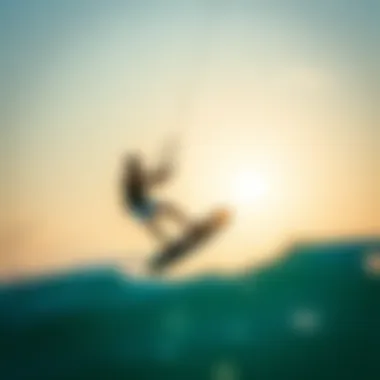
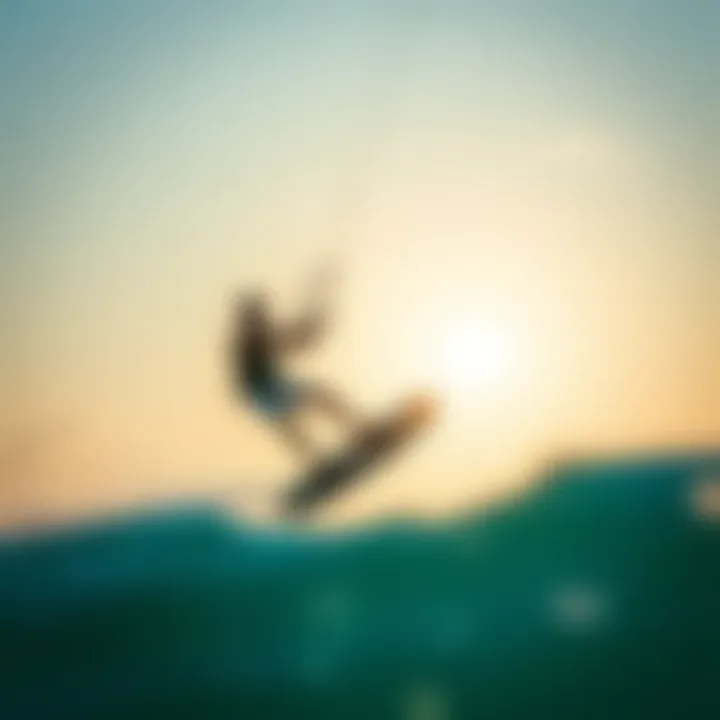
Intro
Kiteboarding in Key West is more than just a sport; it is an experience that blends the thrill of flying over water with the beauty of the surrounding landscape. The region's unique conditions foster an environment that is both challenging and inviting. Whether you are a total newbie curious to dip your toes into the water or an experienced kiteboarder looking to elevate your skills, this guide paves the way for a fulfilling kiteboarding journey.
With its consistent wind patterns, warm waters, and vibrant community, Key West stands as a premier destination for enthusiasts. The intricate dance between the wind and water creates an almost symbiotic relationship, one that can be harnessed with the right understanding and equipment. In the sections that follow, we'll navigate through crucial factors like gear selection, skill enhancement techniques, and the importance of safety and sustainability in kiteboarding. Let’s dive in and get ready to take flight.
Prologue to Kiteboarding in Key West
Kiteboarding has become one of the most exhilarating activities for water sports enthusiasts, particularly in locales where the wind and waves create a perfect backdrop for adventures. Key West, with its breathtaking landscapes and favorable wind conditions, stands as a prime destination for both novice and seasoned kiteboarders. This section will delve into the core attributes of kiteboarding in Key West, evaluating its significance and unique aspects that contribute to its growing popularity.
The allure of kiteboarding in Key West lies in more than just the adrenaline rush; it presents a robust and dynamic community. People from varying backgrounds and skill levels converge here, creating an atmosphere of learning and camaraderie. When considering this sport, one cannot overlook the infectious enthusiasm that permeates through the local scene, inspiring newcomers while providing a supportive network for those seeking to improve their skills.
Benefits of Kiteboarding in Key West
- Ideal Wind Conditions: The trade winds in Key West are reliable, offering consistent kiteboarding conditions. This allows kiteboarders to have longer sessions without frequent interruptions due to shifting winds.
- Diverse Water Environments: From tranquil shallows to more challenging waves, riders can choose what suits them best, promoting growth in skills while enjoying the beautiful scenery.
- Access to Instruction: Numerous schools cater to different levels, making it easier for anyone to get started or refine their skills. Experienced instructors help newcomers grasp safety protocols and techniques efficiently.
Key Considerations
Kiteboarding doesn't come without its challenges. Call it a double-edged sword. The sport demands respect for nature, as environmental considerations often dictate how and when individuals can ride. Moreover, eager novices need to remain mindful of their surroundings, especially in popular riding areas. Each kiteboarder contributes to a collective experience, and being aware of others enhances safety and enjoyment for all involved.
"Understanding your environment is crucial—not just for your safety, but for the well-being of the entire kiteboarding community."
Embracing this sport in Key West also entails acknowledging local regulations and practicing responsible riding. It's essential to stay informed about any guidelines put forth by kiteboarding clubs or environmental organizations to protect both the natural surroundings and the sport’s integrity.
In closing, kiteboarding in Key West is not merely a pastime; it's an experience continuously shaped by the locale's spirit and environmental factors. Grasping the nuances of this vibrant sport will enrich your journey, whether you are looking to ride for fun or pursue more advanced techniques. As we move into the next section, we will explore what the kiteboarding experience entails, shedding light on the thrill it offers to all who partake.
The Kiteboarding Experience
Engaging in kiteboarding is not just about harnessing the wind or gliding over the waves; it's about embracing an adventurous lifestyle, connecting with nature, and experiencing a unique sense of freedom. This section aims to offer readers a comprehensive outlook on what kiteboarding truly means, particularly in the stunning environment of Key West. Here, enthusiasts can chase exhilarating experiences while also considering the finer details that make every ride memorable.
Understanding Kiteboarding
Kiteboarding, also shrouded in the elegance of movement and skill, blends elements of surfing, flying, and wakeboarding. At its core, it's about controlling a power kite while riding a board across the water's surface. Successful kiteboarding hinges on three crucial concepts: kite control, rider balance, and understanding environmental conditions, especially the winds. Each factor plays a pivotal role in ensuring longevity and enjoyment of the sport.
One of the standout features of kiteboarding is its versatility. Riders can engage in various styles, from freestyle tricks like jumps and spins, to more traditional styles like course racing. This adaptability caters to diverse preferences, allowing kiteboarders to carve their niche within the sport.
- Kite control requires practice. Learning to steer and adjust the kite's angle to catch the wind effectively can lead to those breathtaking moments when you feel like you are truly flying.
- Balance is the rider’s best friend. Maintaining a stable position on the board while navigating shifting winds or choppy waters is key to a great ride.
- Lastly, understanding the surroundings, notably the currents and tidal changes in Key West, enhances the riding experience. One moment you may be cruising smoothly, and the next, you could be navigating unpredictable water patterns.
You can explore further at Britannica for a thorough understanding of kiteboarding fundamentals.
The Thrill of the Ride
When you’re out on the water, feeling the rush of the wind and the pull of the kite, there’s a distinct adrenaline high that washes over you. For many kiteboarders, this sense of thrill is what pulls them into the sport time and again. Key West offers an unparalleled backdrop, with its turquoise waters and consistent breezes, all of which combine to create perfect kiteboarding conditions.
A typical session might begin with a serene glide across the surface, but in an instant, it can morph into a high-flying leap over a wave. This unpredictability is part of the adventure; there’s a motif within kiteboarding that keeps you on your toes — the ability to adapt and improvise becomes second nature.
- Jumping and tricks: Among the most sought-after skills, performing aerial maneuvers brings an expected rush, sending hearts racing and spirits soaring.
- Social aspect: Kiteboarding isn't just a solo sport. Community ties form as you share tips and stories with fellow riders, creating a camaraderie bolstered by mutual experiences and challenges faced on the water.
"The thrill of the ride is not just in the act of kiteboarding but in the journey and friendships you forge along the way."
This unique blend of physical challenge, mental focus, and environment engagement transforms each kiteboarding session. You aren't merely riding the waves; you're interacting with nature and learning to navigate its many moods. The emotional high that comes from conquering the winds while sailing over the waves in Key West provides a satisfaction that resonates well beyond the beach, likely to draw you back again and again. For additional insights on the emotions tied to riding, visit Reddit Kiteboarding Community.
In summary, the kiteboarding experience in Key West is multifaceted, providing both a thrilling challenge and a deeply enriching activity. From the initial understanding of the sport to the ultimate thrill of the ride, each element contributes to crafting memories that last a lifetime.
Key West's Unique Environmental Conditions
When it comes to kiteboarding, a day on the water can easily shift from thrilling to challenging depending on the natural conditions. Key West, with its unique environmental attributes, emerges as a hotspot for this exhilarating sport. The combination of consistent wind, favorable water conditions, and naturally beautiful surroundings makes it an irresistible choice for kiteboarders at all levels.
Wind Patterns and Cumulative Knowledge
Understanding the wind patterns is calid to a successful kiteboarding experience in Key West. The prevailing winds during the peak season blow predominantly from the east, creating ideal conditions for both beginners and advanced riders. These winds frequently reach speeds of 15 to 25 knots, providing the lift and power essential for many maneuvers.
Kiteboarders who adapt to these wind patterns often find themselves in a better position to harness the energy efficiently. Learning to read wind dynamics can be a game changer. For instance, the winds tend to be steadier in the afternoon, making it a preferred time for many riders. Wind direction can vary throughout the day, so taking note of local forecasts or consulting with experienced kiters can offer insights into the best times to head out.
Consider not only the wind speed but also other variables that can affect conditions. Gusts and shifts can happen unexpectedly and have the potential to alter your ride significantly. Educating oneself on these wind patterns expands a kiteboarder’s cumulative knowledge, leading to safer and more enjoyable sessions on the water. Lines of communication within the kiteboarding community play a vital role, from word-of-mouth tips to online forums like www.reddit.com where kiteboarders can exchange stories and insights regarding the wind.
Water Conditions and Their Impact


Water conditions greatly influence performance and safety when kiteboarding. In Key West, the shallow waters, particularly on the eastern side of the island, are beneficial for both newcomers and seasoned riders. Shallow areas allow participants to practice without the anxiety of deep water, enabling a less intimidating entry into the sport. Moreover, the crystal-clear water enhances visibility, allowing riders to better navigate their surroundings and avoid obstacles.
Understanding tides is equally important as they can dramatically affect the water level and accessibility to riding spots. During high tide, certain areas may be crowded with other water sports, while low tide can expose more space for kite launches and landings. It’s wise to plan rides around these tidal changes to optimize the experience.
Local factors, such as current and swell height, can also dramatically impact the ride. In a nutshell, mastering the interplay between wind and water enhances a kiteboarder's journey.
"The environment in Key West is like a kiteboarder's playground; knowing how to use its quirks can set the stage for unforgettable adventures."
Seasonal Considerations for Kiteboarding
Understanding the seasonal dynamics of kiteboarding in Key West is crucial for both enthusiasts and novices alike. The interplay of various weather patterns, wind strengths, and tides can dramatically influence the experience on the water. By grasping these elements, kiteboarders can optimize their riding times, ensuring they make the most out of this exhilarating sport. This section ventures into what the different seasons offer and what to keep in mind to have an enjoyable and safe kiteboarding adventure.
Identifying Optimal Times to Ride
Navigating the kiteboarding calendar in Key West often feels like hitting a sweet spot. The wind conditions and water temperatures change with the seasons, influencing the best times to hit the waves. Here’s a closer look at the particulars:
- Winter (December to February): The temps are milder, averaging from the mid-60s to low-70s°F. Winds during this time can be quite consistent, often blowing at a steady 15-20 knots, making it a preferred season for many riders. However, it is important to pack a wetsuit to combat the cooler ocean breezes.
- Spring (March to May): As the weather warms, the wind often picks up too, leading into some peak riding months. This time frame generally presents a blend of warmer conditions, averaging temperatures in the 70s°F, coupled with exciting wind patterns, serving as a magnet for kiteboarders.
- Summer (June to August): Here comes the heat! Temperatures typically soar into the 80s°F. While kiteboarding can still be done, the wind tends to be a bit more sporadic and unpredictable. However, afternoon storms are common and might stir up the wind for some bang-up sessions.
- Fall (September to November): As the summer fades, many kiteboarders flock back, enticed by the return of strong winds after the hurricane season. This period usually offers mild weather and consistent winds in the 15-25 knot range. Riders should always stay vigilant and monitor forecasts, as storm systems can give both opportunities and risks.
Understanding these seasonal variances can greatly fine-tune the kiteboarding experience. Those who keep an eye on seasonal changes are better suited to make the most out of their time on the water.
Incoming Weather Patterns
Weather trends play a big role in kiteboarding, especially in a coastal region like Key West. Knowing how to read these patterns can be the difference between a breezy day on the water and a battle against the elements. Here’s how to stay one step ahead:
- Tropical Storms: The summer months can bring unexpected squalls. It’s crucial to monitor weather reports and remain informed about any tropical disturbances. Storms can rapidly change wind and wave conditions, so preparation and awareness are key.
- Cold Fronts: In winter, cold fronts can sweep over, sometimes bringing gusty winds. These winds can be exhilarating but tricky; knowing how to handle high winds is paramount for safety. Tracking cold fronts through local meteorological channels is smart.
- High Pressure Systems: These typically bring clear, stable weather with consistent winds, and keeping an eye on these can provide fantastic riding days. Understanding the movement of pressure systems can help determine prime sessions.
- Local Weather Services: Talarunable to the nuances of the weather? Rely on resources like the National Weather Service (weather.gov) or local kiteboarding shops that often give real-time conditions and forecasts for kiteboarding.
"Good sailing weather can change quickly; make sure you know how to fish or cut bait when it does."
In summary, being attuned to seasonal changes and incoming weather patterns can enhance the kiteboarding experience. By adjusting plans according to these environmental cues, riders not only heighten their fun but also improve their safety on the water.
Essential Gear for Kiteboarding
Kiteboarding is an exhilarating sport, but just like any other adventure, having the right gear is critical. The essential gear for kiteboarding not only enhances your performance but also ensures your safety on the water. Proper equipment can make the difference between a thrilling experience and a daunting challenge. Let's delve into two key components: selecting your kite and board, and the role of safety equipment.
Selecting Your Kite and Board
When it comes to choosing your kite and board, the options can feel overwhelming. A good starting point is to understand the size and type of kite that suits your needs. Kite sizes vary, and picking the correct one is crucial as they directly relate to wind conditions and your weight. For instance, a larger kite generates more lift, which is ideal for lighter winds; conversely, a smaller kite is preferred for strong winds.
Furthermore, the type of board also influences your ride. There are twin-tip boards, which are good for beginners and allow for switching between feet, and directional boards, which focus on riding in one direction and often provide more speed and fluidity. It's worth mentioning the construction materials, as a board made from fiberglass or carbon fiber can offer durability and better performance, albeit at a higher price point.
In summary, selecting the right kite and board is pivotal. Please consider the following:
- Wind Conditions: A clear understanding of the local wind patterns in Key West can guide your choice.
- Personal Skill Level: Match your gear to your abilities; beginners should opt for user-friendly options.
- Budget: Quality gear tends to require a higher initial investment but can pay off in terms of performance and safety.
The Role of Safety Equipment
Now, let’s talk safety. Kiteboarding can be thrilling, but without appropriate safety gear, it can also be risky. The most fundamental piece of safety equipment is the harness, which connects you to the kite and board. Always choose a harness that fits snugly, as a loose harness could lead to accidents.
Additionally, the use of a quick-release system on your harness can be a lifesaver in emergencies. This mechanism allows you to detach yourself from the kite quickly, should the need arise. Other essential safety gear includes:
- Helmet: Protects your head from impacts.
- Impact Vest: Offers cushioning against falls and provides some buoyancy.
- Leash: Keeps your board nearby during a fall, preventing it from becoming a hazard to others.
- Flotation Device: In some areas, having a personal flotation device may be a legal requirement, but it’s also wise for overall safety.
"Safety should never be an afterthought; it is the backbone of every adventure."
Instructional Opportunities
The significance of quality instruction in kiteboarding cannot be overstated. Instructional opportunities form the backbone of a safe and enjoyable kiteboarding experience, particularly for those just dipping their toes into the water. Learning the ropes from experienced instructors not only accelerates the skill acquisition process but also enhances safety and confidence for novices. In the constant ebb and flow of the wind and waves, having a reliable guide can mean the difference between a thrilling ride and a challenging escapade.
Finding Qualified Instructors
When it comes to finding a qualified instructor in Key West, it’s essential to take a methodical approach. Your journey should start with some research. Look for schools with certified instructors who demonstrate a comprehensive understanding of kiteboarding principles and practices. Not all instructors are equal, and the right one can make a world of difference in your learning experience.
Here are some factors to consider:
- Certifications: Look for instructors who hold certifications from recognized organizations like the International Kiteboarding Organization (IKO) or the Professional Air Sports Association (PASA). These qualifications ensure that instructors have met specific training standards.
- Experience: Speak with locals or online communities to gauge the reputation of different instructors. A well-regarded instructor will often come with a wealth of experience, not just in teaching but also in the nuances of kiteboarding.
- Teaching Style: Everyone learns differently; hence it is worth exploring various instructors’ teaching styles. A good instructor should be able to adapt their methods according to your learning preferences.
"In kiteboarding, choosing the right instructor is as vital as picking the right gear. Your instructor should inspire confidence and safety above all."
You may consider platforms like Reddit for reviews or personal experiences of others, as well as social media groups. Engaging with these communities can provide insights into who to learn from in Key West.
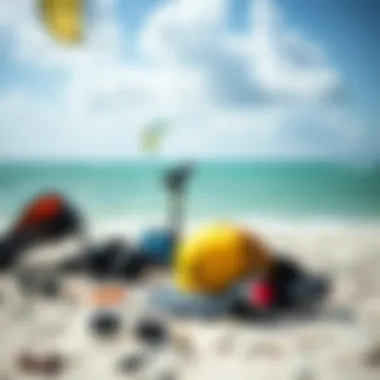
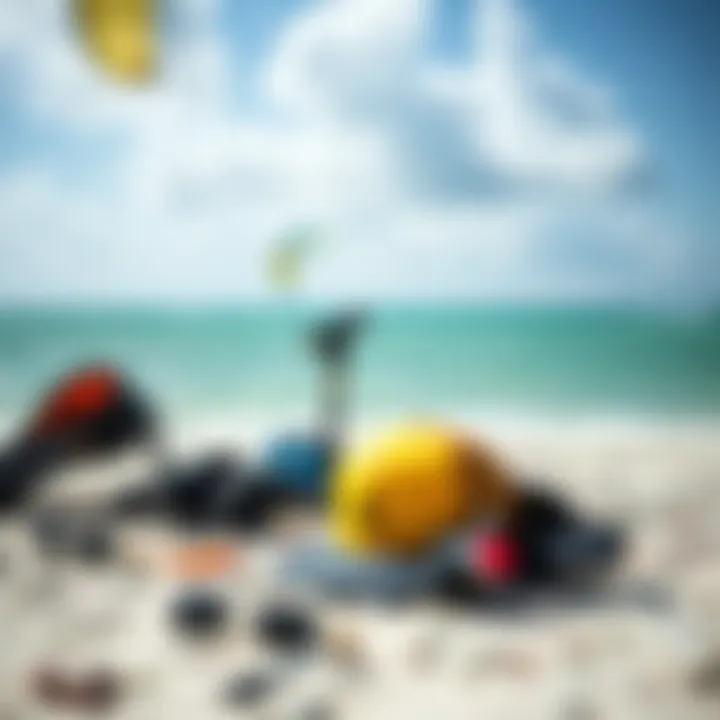
Understanding Certification and Levels
Gaining a grasp on the certification landscape for kiteboarding is equally critical. Not only does it signify an instructor’s proficiency, but understanding advanced levels also allows for tailored training to suit your aspirations.
Most kiteboarding schools outline a progressive learning structure divided into levels. This schema often looks like:
- Beginner Level: Focused on understanding equipment, basic flying skills, and water safety.
- Intermediate Level: Concentration on refining riding skills: turns, switches, and beginning tricks.
- Advanced Level: This level dives deep into complex maneuvers, jump height control, and freestyle techniques.
Certificates such as the IKO or PASA typically accompany each level, which can help in evaluating your skills against standardized benchmarks. Achieving these certifications can also be motivational, marking tangible milestones in your kiteboarding journey.
In summary, finding the right instructional opportunities and understanding the certification process are fundamental steps for anyone serious about kiteboarding in Key West. These elements shape not just how quickly one can learn but also the enjoyment and safety of the kiteboarding experience.
Safety Practices in Kiteboarding
Kiteboarding, while exhilarating, carries its share of risks. Therefore, understanding safety practices is essential for anyone looking to enjoy the sport in Key West, or really anywhere. The right safety protocols not only protect individual kiteboarders but enhance the overall experience for the community as well. When everyone is aware and prepared, it fosters a safer, more enjoyable environment. By being aware of your surroundings and having a strategy, you can navigate potential hazards effectively.
Safety Protocols and Best Practices
Safety protocols form the backbone of responsible kiteboarding. Here are some key practices that kiteboarders should adopt:
- Pre-Flight Check: Before launching your kite, always do a thorough equipment check. Inspect the lines, the kite's fabric, and the harness. Any small tear can lead to a major mishap.
- Kite Size Selection: Choosing the appropriate kite size for wind conditions is crucial. A kite that is too large in high winds can be unwieldy and dangerously difficult to control.
- Launching Area: Pick a launch area that is free of obstacles and other water users. Look for a clear space where you can launch safely without endangering others.
- Wind Awareness: Keep an eye on wind patterns and changes throughout your session. Sudden shifts can catch you off guard.
- Buddy System: Whenever possible, kite with a buddy. Having someone else around can be life-saving should an emergency arise.
- Proper Gear: Ensure you’re wearing a proper impact vest, helmet, and a quick-release mechanism on your harness. These items can dramatically reduce injury risk.
"Safety is not just a practice; it's a mindset. Remember, the ocean is unpredictable. Respect it."
Emergency Procedures and Response
Despite all precautions, emergencies can occur in kiteboarding, and knowing how to respond is vital. Here are some responses that every kiter should familiarize themselves with:
- Self-Rescue Techniques: Learn self-rescue methods. If your kite becomes uncontrollable, knowing how to release it and swim back can save your life.
- Identifying Emergency Signals: Recognize and use hand signals for distress. If injuried, clearly signal for help to others on the water.
- Calling for Help: Familiarize yourself with emergency contact numbers. In Key West, 911 is the primary emergency help line, but understanding which local resources are available can also be beneficial.
- First Aid Knowledge: Basic first aid knowledge can go a long way. Knowing how to treat common kiteboarding injuries, such as cuts or sprains, can make a big difference until professional help arrives.
- Equipment Knowledge: Be knowledgeable about your gear’s safety features. Understanding how it all works prepares you for any situation.
Adhering to these safety practices not only enhances your kiteboarding experience but also builds a community of responsible water users. Everyone benefits when safety is prioritized, leading to enjoyable kiting sessions in the vibrant waters of Key West.
Enhancing Skills for Advanced Kiteboarding
Kiteboarding, much like any sport, is a dynamic journey of improvement and exploration. Once you’ve got the basics under your belt, it's time to ladder up your skills and really embrace what this thrilling activity has to offer. Enhancing abilities in kiteboarding is pivotal—not just for personal satisfaction but also for safety and overall enjoyment on the water. Understanding the nuances of technique, developing physical fitness, and engaging with a community of fellow kiteboarders all contribute to elevating one’s kiteboarding game.
Techniques for Progression
As you dive deeper into kiteboarding, embracing new techniques is key to reaching the next level. Progression isn’t just about throwing tricks; it’s about refining your style and mastering the art of riding. Some techniques you might consider are:
- Jumping: Start small and work on clearing obstacles. Use the power of the kite to boost yourself into the air gracefully. You need to master control during descent to land safely.
- Transitions: This involves changing directions seamlessly while maintaining speed. The smoother your transitions, the more fluid your riding will appear.
- Board-Offs: These tricks involve taking your board off and juggling it mid-air. It’s challenging but shows a great command over the kite.
- Old Tricks Made New: Revisiting techniques you've learned before can add variety to your skillset. Sometimes, a fresh perspective on established moves can enhance your confidence.
Continuous practice, reading tutorials, and watching technique progression videos are all valuable ways to improve. Connecting with an instructor who has a knack for teaching intermediate strategies can expedite your journey.
Charting Personal Growth
Monitoring your progress is a crucial step in advancing your kiteboarding skills. Charting personal growth gives you a clearer view of how far you've come and what areas still need work. Keeping track can be as simple as maintaining a journal or using an app to document:
- Personal Milestones: When you successfully execute a new trick or overcome a specific challenge, write it down. Celebrate small victories, as they lay the groundwork for bigger achievements.
- Conditions and Performance: Note the water and wind conditions during sessions. Understanding how these factors affect your riding can refine your skills further, making you a more adaptable kiteboarder.
- Setting Goals: Aim for short and long-term objectives. Start with achievable targets—like refining your jump height—then work up to more complex aspirations, such as mastering a difficult trick.
- Feedback Loop: Engage with instructors or experienced kiteboarders to receive constructive critiques. Fellow kiteboarders are often happy to share insights or tips that can accelerate your growth journey.
"Continuous learning is the mother of skill. Each ride, each trick, and each turn teaches you something new about kiteboarding and, indeed, about yourself."
Valuable Resources
For those seeking more insight into honing their skills, consider checking out resources like Wikipedia's Kiteboarding page or Britannica on Kite Surfing. Also, engaging with forums on Reddit or local Facebook groups can connect you with a wealth of knowledge from other kiteboard enthusiasts, providing tips and insights into navigating the waters in Key West.
Utilizing these techniques alongside personal reflection can help carve a successful path in kiteboarding, making every ride a step towards mastery.
Building a Community in Key West
Kiteboarding isn’t just a sport; it's a way of life for many in Key West. Building a community centered around this activity serves numerous purposes beyond just riding the waves. It fosters camaraderie among kiteboarders, enhances safety, and creates a vibrant culture that carries the spirit of mutual support and enthusiasm. In this section, we’ll unpack why a tight-knit community is essential for new and seasoned riders alike, as well as how local events and gatherings play a pivotal role in forging connections.
Local Events and Gatherings
Events in Key West have the knack of bringing kiteboarding enthusiasts together. These gatherings are not mere social functions; they foster an environment of learning and sharing among kiteboarders of various skill levels. Notably, events such as the annual Key West Kiteboarding Competition showcase the talent within the community and attract participants and spectators alike.
- Competitions: These events, aside from providing an adrenaline rush, allow local riders to compete, and the thrilling atmosphere is electrifying.
- Workshops: Hosting workshops focusing on safety protocols as well as advanced techniques can also be quite beneficial. It’s a golden opportunity to not only enhance one’s skills but also to engage with instructors and exchange insights.
- Themed Gatherings: Whether it’s beach clean-ups or charity events sponsored by local businesses, these initiatives strengthen ties and underscore kiteboarding's role in environmental stewardship.
By participating in these events, riders build camaraderie and gain invaluable insights, making for a richer kiteboarding experience.
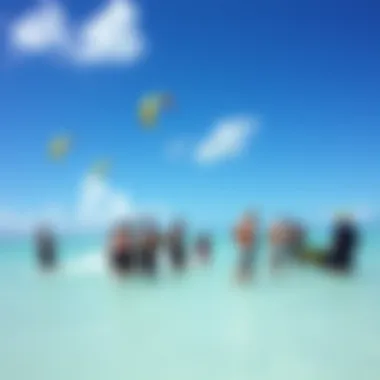
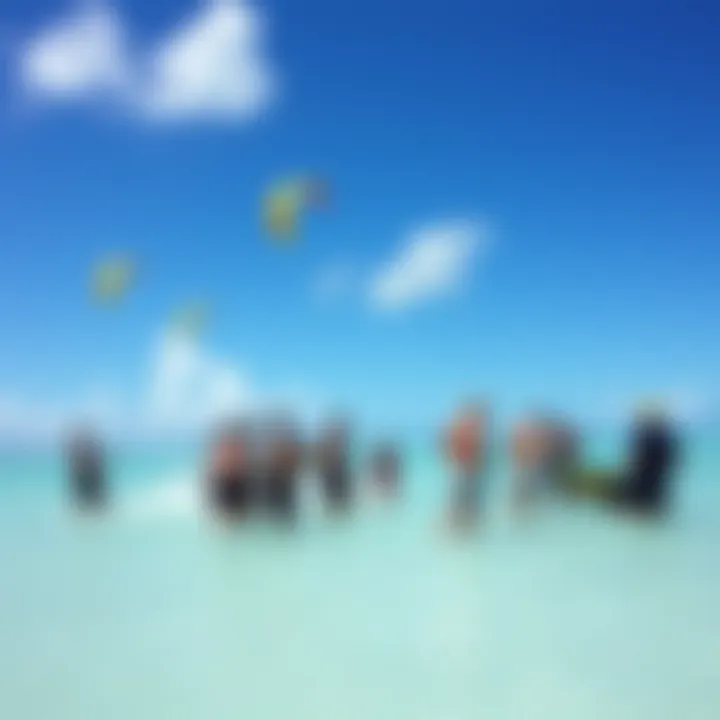
Connecting with Fellow Kiteboarders
Networking within the kiteboarding community is essential. When you connect with fellow kiteboarders in Key West, you tap into a wellspring of shared knowledge and experience. Many seasoned riders are eager to share tips on technique, gear, and the best spots for riding on different days.
- Learning from Each Other: The value of mentorship cannot be overstated. New riders can gain firsthand support and advice on navigating the waters safely and efficiently.
- Social Media Connections: Platforms like Facebook and Reddit host groups dedicated to Key West kiteboarding. Here, updates about equipment recommendations, conditions, and social meet-ups are shared regularly.
- Friendships: Beyond the practical benefits, these connections often lead to friendships that extend beyond the water. Together, fellow kiteboarders can experience the joy of the sport, from hitting the waves at dawn to chilling out with a sunset view.
"The rad thing about our community is that it’s built on passion and respect for the sport. We lift each other up!"
Understanding the significance of community in Key West kiteboarding can truly elevate your experience. Being a part of local events and forming connections not only enhances your skill set but also strengthens your ties to this vibrant sport. Whether you are just starting out or looking to refine your techniques, immersing yourself in this community adds layers of fulfillment to the journey.
Environmental Considerations in Kiteboarding
Understanding environmental considerations is crucial for kiteboarding enthusiasts and instructors alike. As the allure of flying across the crystal-clear waters of Key West attracts many, recognizing the impact of kiteboarding on the environment becomes increasingly significant. By adopting environmentally sound practices, the kiteboarding community can ensure that both the sport and the natural ecosystems continue to thrive. It's not just about having fun on the water; it's also about preservation for future generations.
Sustainability Practices
Sustainability practices play an essential role in maintaining the delicate balance between enjoying the sport and protecting our oceans. Here are some recommended practices kiteboarders and schools can observe:
- Choose Eco-Friendly Gear: The kiteboarding industry has evolved, and many manufacturers produce gear using environmentally friendly materials. From kites made with less harm to the oceans to boards that are sustainably sourced, opting for eco-friendly options is a step towards reducing one's carbon footprint.
- Responsible Riding Locations: Respecting local regulations and choosing spots designated for kiteboarding helps minimize disruption to wildlife. Areas teeming with marine life should be kept off-limits to preserve the habitat.
- Waste Management: Always carry out what you bring in. Plastic waste is a significant threat to marine life, and it's essential to keep the beaches and waters clean. Join local clean-ups or create initiatives that encourage fellow kiteboarders to do the same.
Implementing these practices is not only a show of respect for the environment but can also resonate with clients who are interested in eco-friendly activities. Every little action matters and can help make a difference.
Conservation Efforts in Key West
Key West is endowed with its unique ecosystems that are worth protecting. Local conservation efforts often focus on marine life and habitats that are vulnerable to various activities, including tourism and sports. Some key conservation initiatives include:
- Protection of Coral Reefs: Coral reefs serve as essential ecosystems in the ocean, playing a crucial role in supporting marine biodiversity. Organizations like the Florida Keys National Marine Sanctuary promote awareness and protection efforts to ensure the health of these reefs. Visitors can find information on conservation programs through resources such as noaa.gov.
- Education and Community Involvement: Local kiteboarding schools often engage in educational outreach. They conduct workshops teaching riders about local wildlife and guidelines that help in conserving the environment. Understanding the impact of their actions empowers riders to advocate for the preservation of their riding areas.
- Habitat Restoration Projects: Various groups rally together to restore damaged environments, including mangroves and seagrass beds. These projects enhance water quality and provide crucial habitats for fish and other wildlife.
By actively participating in such efforts, both individuals and organizations contribute to a healthier marine environment, which ultimately enhances the kiteboarding experience in Key West.
"The greatest threat to our planet is the belief that someone else will save it." – Robert Swan
Kiteboarding can coexist with nature if participants approach the sport with a mindset inclined towards sustainability and conservation. Supporting these natural environments not only preserves them but also ensures that the thrill of kiteboarding can continue to be enjoyed by future generations in Key West.
Exploring the Future of Kiteboarding
The field of kiteboarding is not static; it is ever-changing and influenced by advancements in technology, shifts in societal preferences, and an increasing awareness of environmental responsibilities. Understanding the trajectory of kiteboarding helps enthusiasts, whether they are novices or experienced practitioners, to not only enjoy the sport but also engage with it responsibly.
As we look to the future, several key areas stand out, including innovations in equipment and techniques alongside evolving societal trends. These factors contribute to the ongoing growth and sustainability of kiteboarding in places like Key West, making it essential to keep an eye on what lies ahead.
Innovations in Equipment and Techniques
Advancements in kiteboarding equipment can entirely alter the way the sport is experienced. Each year, manufacturers push the boundaries with lighter, more durable materials and smarter designs that maximize performance and safety. For instance, the use of carbon fiber not only reduces weight but increases strength, allowing riders to maneuver easily and enhance their tricks.
New techniques are also emerging, with riders increasingly using foil boards that glide over the surface of the water, giving a sense of flying. This opens doors to new styles of kiteboarding, attracting those who may have been hesitant to try traditional boards. As technology progresses, we expect to see the integration of smart sensors in kites and equipment that can analyze wind patterns and optimal performance metrics in real-time.
Additionally, innovations like inflatable kites have made the sport more accessible, allowing beginners to get airborne with less hassle. Safety mechanisms, such as quick-release systems and improved harness designs, heighten the security of riders in adverse conditions.
"With the rapid evolution of kiteboarding gear, it is crucial for kiteboarders to stay informed and adapt to new technologies to enhance their skills and ensure their safety."
Societal Trends and Participation Rates
Kiteboarding has seen a surge in participation across various age groups, and understanding these societal trends is crucial for fostering a thriving community. The rise of social media has propelled the visibility of kiteboarding, showcasing thrilling stunts, picturesque locations, and inspiring stories. This visibility not only draws in newcomers but also strengthens the bonds among existing enthusiasts, fostering a sense of belonging.
Moreover, as more people become attuned to the health and fitness benefits of outdoor activities, kiteboarding’s allure as an engaging workout is undeniable. Besides strengthening muscle and improving cardiovascular health, it offers a unique escape from daily pressures, promoting mental well-being. Evidence suggests an increase in participation rates among younger generations, who are often drawn to extreme sports and new adventures.
Provisions for community building, such as local competitions, workshops, and environmental initiatives, have also played a huge role. These events do not simply enhance skills but help foster connections, creating a vibrant social fabric that defines the kiteboarding culture. The local economy benefits too, as businesses offering kiteboarding rentals, lessons, and gear see increased demand, solidifying Key West as a premier destination.
As we navigate the future of kiteboarding, staying connected with these trends not only enhances our experience but also bolsters the community at large, ensuring that everyone has a part to play in maintaining the sport's integrity and enjoyment.
End: Navigating the Kiteboarding Journey
Kiteboarding, especially in a vibrant locale like Key West, is more than just a sport; it’s a multifaceted journey that involves embracing both the thrill of the ride and the intricacies of the surrounding environment. This closing section synthesizes the insights gleaned throughout the article, encapsulating the essential elements that define the kiteboarding experience in this unique destination.
As kiteboarders, new or seasoned, navigating the waters means understanding the fine balance between excitement and responsibility. With varying wind patterns that can turn on a dime and water conditions that demand respect, acknowledging these factors plays a critical role in ensuring not just your safety but also enhancing your enjoyment. Choosing the right time to hit the waves is crucial. The seasonal winds offer distinct advantages, and knowing when the conditions are ripe can make all the difference.
Key Considerations:
- The environment shapes every aspect of kiteboarding, urging riders to adapt and learn.
- Gearing up with the right equipment can significantly enhance the experience. It’s vital to prioritize quality and safety.
- Engaging with professional instructors may appear optional for some, but building a solid foundation of skills can save many headaches down the road.
- Finally, contributing to the local community through participation in events and supporting conservation efforts helps maintain the delicate balance between thrill-seeking and environmental responsibility.
"Kiteboarding is not just about the thrill; it's about respect—for the ocean, the wind, and each other."
When one truly appreciates the impacts of their actions, every session on the water becomes an opportunity for growth—not just as a boarder, but as a steward of the water.
In summary, whether you’re just dipping your toes in or you’re already carving out waves, kiteboarding in Key West is a commitment that extends beyond the ride. By navigating your journey with a sense of curiosity and responsibility, you not only enhance your skills but contribute to a culture that values the exhilarating union of sport and nature. Embrace this adventure, respect your surroundings, and you will find a profound connection to the winds and waters of Key West.















